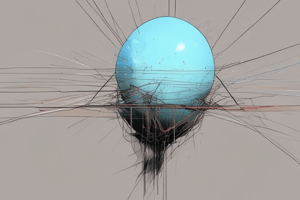Podcast
Questions and Answers
What happens when two objects made from insulating materials come into contact via friction?
What happens when two objects made from insulating materials come into contact via friction?
- They become electrically neutral.
- They both gain protons.
- They both lose all their electrons.
- One object becomes positively charged and the other negatively charged. (correct)
Only electrons can be transferred between objects through friction.
Only electrons can be transferred between objects through friction.
True (A)
What is the term for an object that has more electrons than protons?
What is the term for an object that has more electrons than protons?
anion
Static charge can build up through the process of __________ between two insulating materials.
Static charge can build up through the process of __________ between two insulating materials.
Match the following charging processes with their descriptions:
Match the following charging processes with their descriptions:
What primarily causes the buildup of electrical charges in clouds?
What primarily causes the buildup of electrical charges in clouds?
A Van de Graaff generator can demonstrate the process of charge discharge.
A Van de Graaff generator can demonstrate the process of charge discharge.
What is created when the charge difference in clouds becomes significant enough?
What is created when the charge difference in clouds becomes significant enough?
The bottom roller of a Van de Graaff generator is made out of ______.
The bottom roller of a Van de Graaff generator is made out of ______.
Match the components of a Van de Graaff generator with their functions:
Match the components of a Van de Graaff generator with their functions:
Flashcards are hidden until you start studying
Study Notes
Friction and Static Electricity
- Objects typically remain neutral, having equal numbers of positive (protons) and negative (electrons) charges.
- Objects can become charged through friction, which transfers electrons between them; protons and neutrons remain fixed and do not transfer.
- An object with more electrons than protons is negatively charged (anion), while one with fewer electrons than protons is positively charged (cation).
- Like charges repel each other; negative repels negative and positive repels positive.
- Opposite charges attract each other; negative attracts positive and positive attracts negative.
Sparks, Shocks, and Earthing
- Static charge builds up primarily through friction between insulating materials.
- Excess electrons become fixed on the surface of the material creating a static charge.
Charging Mechanisms
- Charging by Friction: Involves two insulating objects making contact and rubbing together, resulting in electron transfer; one object loses electrons (positively charged) while the other gains electrons (negatively charged).
- Charging by Induction: Achieves charge redistribution within an object without contact, triggered by bringing a charged object near it, temporarily shifting charges.
- Charging by Conduction: Involves direct contact between a charged object and a neutral object, allowing electron flow until charges equalize.
Discharge in Nature
- Charge Buildup: Atmospheric conditions, such as moving ice and water droplets in clouds, create friction and build up electrical charges.
- Separation of Charges: Positive charges accumulate at the cloud's top while negative charges gather at the bottom, generating an imbalance similar to a battery.
- Formation of Lightning: When charge differences become significant, they create a force strong enough to overcome air resistance and produce lightning.
- Lightning Strike: Visible electric discharge that rapidly travels, heating up the air and producing a bright flash.
- Discharge: Lightning neutralizes charge buildup, allowing positive and negative charges to balance.
- Effects of Lightning: Can be extremely hazardous, causing fires, damage to structures, and posing risks to living organisms.
Van de Graaff Generator
- A device designed to create charge and demonstrate electron discharge.
- Components include:
- Motor
- Metal sphere
- Grounded discharge rod
- Conveyor belt
- Two brushes
- Two rollers
- Functionality: A motor at the base turns a roller that drives a belt. Friction occurs as the bottom brush rubs against the belt, generating static electricity.
- Materials: The bottom roller is silicon, retaining negative charges, while the top roller is aluminum, retaining positive charges, allowing for effective charge transfer and demonstration.
Studying That Suits You
Use AI to generate personalized quizzes and flashcards to suit your learning preferences.




